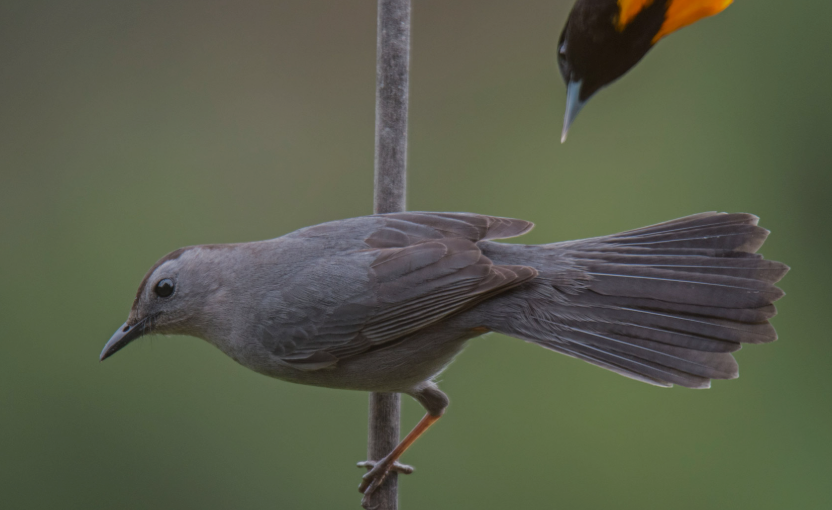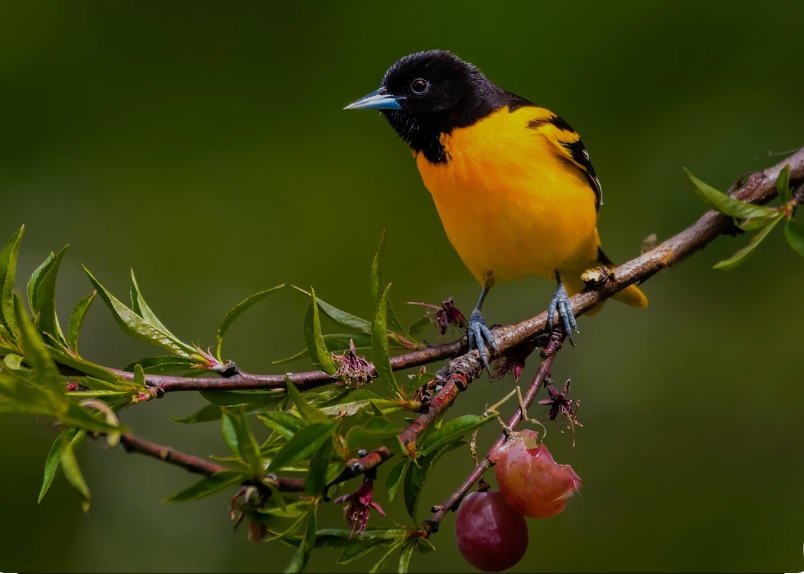
Grape jelly has become a surprising but highly effective food for attracting certain avian species to backyards. Its ultra-sweet, potent aroma and deep, fruit-like color act as powerful attractants, mimicking the high-energy, sugary fruits these birds naturally seek out in the wild. This makes it an irresistible treat, particularly for those with a strong dietary preference for fruit and nectar.
The birds most famously associated with this preference are orioles and catbirds. Their specialized, slightly pointed beaks are perfectly adapted for probing and lapping up the soft, gelatinous substance. The intense sugar concentration provides an immediate burst of energy, which is crucial for these species during the demanding periods of migration and breeding, making a jelly dish a valuable resource.
In addition to orioles, other fruit-loving birds such as Gray Catbirds and Northern Mockingbirds are known to enjoy grape jelly. These species naturally eat berries and fruits, so jelly is an easy substitute when offered.
In backyard settings, offering jelly can encourage regular visits and even bring in species that are otherwise shy or uncommon. The bright color and strong scent of grape jelly make it easy for birds to locate, and once they do, they may integrate it into their daily feeding routine. This makes jelly feeders an effective way for bird enthusiasts to attract activity and song into their gardens.

Birds That Eat Grape Jelly
Baltimore Oriole
Baltimore Orioles are the most famous jelly lovers. Their vibrant orange and black plumage makes them a joy to spot at feeders. In spring, grape jelly is an important energy source after their long migration from Central and South America. Orioles prefer jelly served in shallow cups or dishes, often alongside orange halves.
Orchard Oriole
Slightly smaller and less brightly colored than the Baltimore Oriole, Orchard Orioles also enjoy grape jelly. They arrive in late spring and readily visit feeders where jelly and fruit are offered. Their preference for sweet foods makes jelly an excellent supplement to their diet of insects and nectar.
Bullock’s Oriole
Native to the western United States, Bullock’s Orioles have striking orange, black, and white plumage. Like their eastern cousins, they are drawn to feeders with grape jelly. During breeding season, providing jelly helps sustain their energy demands while raising chicks.
Hooded Oriole
Found mainly in the southwestern U.S. and Mexico, Hooded Orioles are another oriole species that relishes grape jelly. Their bright yellow-orange bodies and black throats make them stand out. They often share feeders with other orioles when jelly is available.
Scott’s Oriole
Scott’s Orioles, with their lemon-yellow bodies and black heads, are common in desert regions. They, too, have a sweet tooth and will eagerly eat grape jelly when it is offered at feeders. This high-sugar food helps them cope with hot climates and long foraging flights.
Northern Mockingbird
Mockingbirds are omnivorous and opportunistic. They feed on insects, berries, and fruit, but when grape jelly is offered, they won’t hesitate to indulge. They often dominate feeders and may chase off smaller birds to secure access to the sweet treat.
Gray Catbird
Catbirds are close relatives of mockingbirds and share a love of fruit and jelly. Their slate-gray feathers and cat-like calls make them easy to recognize. Catbirds frequently visit feeders stocked with grape jelly, especially during migration.
American Robin
While robins are best known for eating worms, they also enjoy berries and fruits. In some areas, robins will sample grape jelly at feeders, particularly when natural fruit sources are scarce. They may not be as consistent as orioles, but they can develop a taste for it.
Red-bellied Woodpecker
Though mainly insect eaters, Red-bellied Woodpeckers have a sweet tooth. They are known to visit jelly feeders, especially in spring and summer. Their bold red caps and loud calls make them easy to spot when they come to snack on jelly.
Downy Woodpecker
These small woodpeckers also occasionally eat grape jelly. They primarily feed on insects, but they will take advantage of sweet, high-energy foods when available. Their small size makes them less aggressive at feeders compared to larger species.
Yellow-rumped Warbler
Warblers migrate long distances and need high-energy foods. While they typically consume insects and berries, they sometimes visit jelly feeders, especially in the spring. Grape jelly provides them with a quick sugar boost during migration.
House Finch
House Finches, known for their red-streaked plumage, are opportunistic feeders. While they primarily eat seeds and fruit, they can be attracted to grape jelly as well. Their willingness to try new foods often leads them to jelly feeders in urban and suburban areas.
European Starling
Starlings are highly adaptable and opportunistic. They consume insects, grains, and fruits, and they will eagerly eat grape jelly if they find it. However, they can be aggressive at feeders, often dominating and chasing away smaller birds.
Rose-breasted Grosbeak
These striking birds, with their black-and-white plumage and bright red breast patch in males, are fond of fruit and nectar. They will readily sample grape jelly at feeders, especially during spring migration when extra energy is needed.
Blue Jay
Blue Jays are clever and curious omnivores. While they are most often seen cracking acorns or raiding feeders for peanuts, they also enjoy sweet foods like berries and grape jelly. Their bold nature allows them to quickly take over a jelly feeder.
Cedar Waxwing
Cedar Waxwings are fruit specialists, known for flocking to berry-laden trees. They also have a sweet tooth and can be attracted to jelly feeders. Their sleek, silky plumage and yellow-tipped tails make them easy to recognize.
Scarlet Tanager
These brilliantly colored birds, with their vivid red bodies and black wings, migrate long distances from South America. They occasionally stop at jelly feeders to refuel. While insects are their main food, the sugar-rich jelly provides valuable energy.
Summer Tanager
Closely related to the Scarlet Tanager, the Summer Tanager also enjoys fruit and will feed on grape jelly. Their all-red plumage in males is eye-catching. During migration, they benefit from the high sugar content of jelly.
Brown Thrasher
Brown Thrashers are omnivores, eating insects, seeds, and berries. They are known to investigate jelly feeders and will lap up grape jelly when offered. Their bold streaked plumage and long tails make them distinctive.
Eastern Bluebird
While primarily insect eaters, Eastern Bluebirds also enjoy fruit and berries. Some backyard birdwatchers have reported them taking jelly, especially in early spring. This extra sugar helps them through colder days when insects are scarce.
Western Tanager
These western songbirds, with their yellow bodies and red-orange heads, are attracted to fruit and nectar sources. They will occasionally stop at jelly feeders, especially during migration. The energy-rich jelly helps them sustain long flights.
American Crow
Though crows are more often associated with scavenging, they are surprisingly fond of sweet foods. They will sample grape jelly when available, though their large size and boldness can discourage smaller birds from feeding nearby.
House Sparrow
House Sparrows are opportunistic feeders and will try nearly anything. Although seeds are their staple food, they sometimes consume grape jelly, especially when it is readily available at backyard feeders.
Tufted Titmouse
These small, lively birds usually feed on seeds, nuts, and insects. However, they sometimes investigate jelly feeders and take a few tastes. Their curiosity and adaptability allow them to sample a wide range of foods, including grape jelly.
Black-headed Grosbeak
These western relatives of the Rose-breasted Grosbeak have striking orange-brown plumage with black and white wings. They are fruit and insect eaters but are also strongly attracted to grape jelly at feeders. Many backyard birders in the western U.S. use jelly to draw them in during migration.
Pine Warbler
Unlike many warblers that feed mostly on insects, Pine Warblers readily consume seeds, suet, and fruit. They sometimes stop at feeders for grape jelly, especially when insect populations are low. Their adaptability makes them more likely than other warblers to return to jelly feeders.
Gray Jay (Canada Jay)
Known as the “camp robber” for its boldness around humans, the Gray Jay eats a wide variety of foods, including fruits and sweets. In northern forests, they may sample grape jelly when provided, though they are more often drawn to suet and scraps.
White-breasted Nuthatch
Primarily insect and seed eaters, White-breasted Nuthatches are curious feeder visitors. They sometimes taste grape jelly, especially in spring and fall when they seek out high-energy foods. Their acrobatic feeding style makes them entertaining to watch at jelly cups.
American Goldfinch
Best known for eating seeds, particularly thistle, American Goldfinches also sample fruit and jelly on occasion. During breeding and migration, they may be attracted to grape jelly as an extra sugar source, though not as frequently as orioles or catbirds.